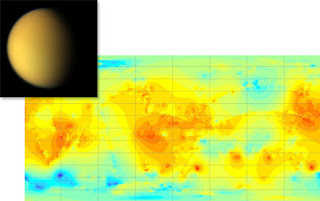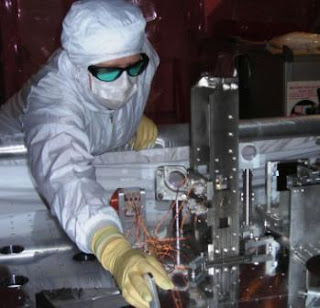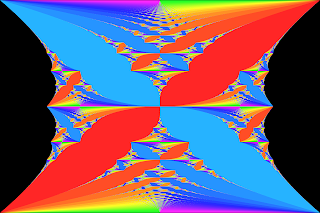Dern walked out of the lift onto the stasis level, holding his temper in check as the gunman prodded him a second time. Passengers huddled fearfully on the floor as leering, rifle toting captors loomed over them.
Dern counted ten hijackers. Six men, four women. He didn’t recall a single face from the outset of the voyage. They must have boarded the ship after Dern had settled into his tube. How did they manage to smuggle weapons on board? Unless they didn’t need to…unless they had inside help.
He noticed Cyril and his wife sitting on the floor near the last stasis chamber embracing each other. He eased down next to the couple.
Satisfied that the curious passenger was where he was supposed to be, the big hijacker turned and headed back to the lift.
“This is a nightmare,” Theresa whispered, her voice laden with fear and desperation. “What do they want with us?”
“They’ve rerouted the ship to another star system,” Dern replied quietly, glancing furtively at a nearby hijacker. “The ringleader says we’re going to be dropped off there.”
“They didn’t reroute the ship,” Cyril commented with certainty. “The coordinates to Ceres 3 were never laid in. If they were, our tubes would never have revived us when they did.”
Dern’s eyes sharpened with interest.
Theresa fixed a puzzled gaze on her husband. “What are you saying?”
“Someone on the bridge did not set a course for Ceres 3.” Cyril squinted. “That may or may not have happened with the captain’s consent.”
“The captain looked pretty banged up,” said Dern. “I doubt he’s working with these thugs.”
“Well, I can guarantee you, somebody among the crew is.” Cyril looked at his wife, more angry than frightened. “I guarantee it.”
Dern could only agree. “There could be more than one.”
Tunnal sat in the captain’s chair, his weapon holstered. He didn’t have to worry about a crewmember making a go for it. At this point they were nothing more than scared rabbits. And with his associates on hand to stifle temptations the hijack leader couldn’t have felt more secure.
A hum from one of the bridge stations interrupted an orderly silence. Tunnal swiveled to the source, then glanced at the captain. “What’s that?”
The captain moved toward the station, peering over the operator’s shoulder. “Just a minor strain in the left flank thruster.”
Tunnal shot up from the chair, his hand hovering threateningly above his Viper’s grip. “Is this a ploy of some kind? You trying to hamper us?”
A tension that couldn’t possibly get any thicker, hardened to stone. The captain did his best to project an unflappable demeanor. “No ploy. Had you allowed us to do a systems check after switching engines to manual we could have addressed this issue early on.”
Tunnal didn’t like the captain’s attitude, but a point was a point. He propped on the chair’s armrest, making a fluttering motion. “Carry on. Address this issue. But I want us in System 382 in three days.”
“We’ll get you there sooner. But how do we know this place will be accommodating for my passengers and crew?”
“You don’t.” Tunnal stared at the captain as if daring the officer to challenge him further on the topic. “Will that be all, Captain?”
Appearing slightly hesitant, the captain forced a sharp nod and turned away.
Josik sauntered over to his leader. “I know that preening sod will be the first one you take down,” he whispered harshly.
Tunnal thought briefly before shaking his head. “Perhaps not. I may go after the passenger that was up here.”
Josik’s eyes narrowed curiously. “Why him?”
“I don’t know. There’s something about him. I can’t place it.” Tunnal slapped a hand on his knee. “Either way, this will all be over soon.”
“I have a sister on Ceres 3.” Ura reflected, wrapping her arms around her knees.
Passengers sat along both sides of the corridor walls, avoiding eye contact with the hijackers.
Dern was perched beside the woman, listening, yet observing every detail of the gunmen, from their garb to their mannerisms.
Nine hijackers occupied the level. Two wore short sleeve shirts revealing arms layered in colorful tattoos. He paid particular attention to those tattoos when one or the other walked by.
The hijackers seemed detached enough. They didn’t mistreat passengers. In fact they barely spoke at all, except to each other, and then only in brief exchanges.
“I was going to join her,” Ura continued, her eyes glistening. “I haven’t seen her in a decade.”
“You’ll see her again,” Dern said, preoccupied with one of the tattooed hijackers. “This is just a delay.”
“A delay.” Ura dabbed at a tear with the back of her hand. “Are you always this optimistic?”
“Optimism is good for your health.”
Dern looked to Cyril and Theresa who sat on his other side.
They eagerly anticipated spending their retirement years away from the stress and strain of an overcrowded Coalition world. Of course given the rapidity with which Coalition frontier worlds were being settled, Dern doubted Ceres 3 would remain so pristine for long.
“Looks like you’ll be late reporting to your new job,” Cyril remarked, trying his best not to look worried.
Dern offered a wry smile. “I’m sure my boss will understand.”
“What do you think this System 382 planet is like?” asked Theresa.
“Sounds like a place that harbors unsanctioned settlements.” Dern could have told her that the planet was very likely a nest of cutthroats, smugglers, pirates and every assortment of criminality known and reviled by decent folk. But he didn’t want to alarm her…or anyone else within earshot.
The tattooed hijacker he was studying walked past, assault rifle resting on his shoulder.
Dern noticed five orange four point star tattoos linearly positioned underneath the hijacker’s right forearm. The sight gave him pause. Individuals employed by cartels in the Petra Cluster typically marked parts of their bodies with orange stars symbolizing how many victims they killed. A person associated with a Petra cartel never allowed himself to be outsourced unless there was blood work involved.
“Are you…ok?”
Dern turned to Theresa. His sudden look of concern obviously unnerved her. He put on a show of reassurance. “I’m fine. I was just…considering putting in for some vacation time when I start my job. I’m going to need some substantial recovery time from this ordeal.” He grinned.
Cyril and Theresa grinned too.
Ura brightened, but not enough to outshine her distress.
The fourth planet in System 382 appeared a bright and richly textured sienna on the bridge’s primary display screen.
The hijackers eyed the image in quiet jubilation.
The crewmembers calmly focused on their tasks as if under normal circumstances.
“We have no data on this world,” the captain said to Tunnal. “Perhaps you can show us where to make entry…if you don’t mind.”
Tunnal glanced sharply at the captain. “I would watch my tone if I were you. Have one of your specialists zero in on the planet’s lower western hemisphere. That’s where you’ll land this ship.”
“And you’ll let us go.”
Tunnal met the captain’s gaze with an almost wounded look. “Isn’t that what I said?” He turned away, throwing up a haughty gesture. “Now do as I say. Magnify.”
The captain nodded to a crew person across the bridge.
A second later the image drew closer, until a rocky terrain covered the screen. The picture resolved further, revealing the geometric outlines of buildings and launch-landing platforms.
“Captain,” an officer announced. “There’s a transmission coming from the planet.”
“That’s my good buddy, Hooper!” Tunnal laughed, practically bounding toward the captain’s chair. He looked at the officer, instantly disregarding the pretence of honoring a chain of command. “What the hell are you waiting for? Put my buddy on the screen.”
The officer complied and a man’s heavily bearded visage replaced the planetary vista.
A very prominent scar meandered down the left side of the man’s face, disappearing into his hairy foliage.
“Hooper, you ugly son of a bitch,” Tunnal beamed.
The man exposed a wide, toothy grin. “Don’t be jealous, snake face. About time you showed your pitiful hide in these parts.”
“No argument there. Too much time spent cavorting in Coalition space. I’ve got some serious taint to remove.”
“I’ll tell my staff to prep for your arrival. You and your team’ll have the usual comforts waiting for you.”
Tunnal waved a hand around him. “And you’ll have the latest transportation to add to your inventory.”
Hooper’s eyes glistened with anticipation. “Can’t wait. Transmitting approach vector coordinates.” His image vanished.
Tunnal turned to the captain. “Just follow the coordinates he’s sending. Once we land our business with you will be done.”
The captain kept his face blank, his tone carefully neutral. “My passengers will be allowed to keep their possessions?”
“We’re not petty thieves.” Tunnal glanced at the other hijackers who obviously shared their leader’s amusement. “The ship is all we’re interested in.”












